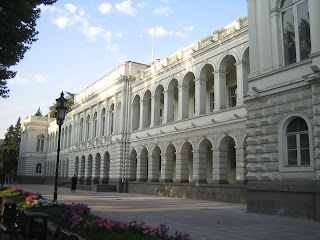As I mentioned in my previous post, this is the first in a several part series summarizing the classic book Architectural Composition, 1908 by John Beverley Robinson. This wonderful book is a treasure trove of design principles written during the architectural zenith that occurred at the turn of the last century. These design principles are quite universal as they grow from the way humans naturally perceive and process the built environment through their senses. These design principles are therefore as useful for us today as they were in Robinson's own time.
Robinson begins his discussion with the design characteristic he considers most essential: unity.
Robinson begins his discussion with the design characteristic he considers most essential: unity.
Robinson defines, "in all works of fine art there is one fundamental quality which from antiquity has been recognized as essential. This quality is unity." Great architecture provides a sense of clarity, harmony and legibility. Architecture that embodies these traits, and that eliminates discord, is said to possess unity.
Robinson explains, "one of the chief sources of unity in the arts of design, including architecture, lies in the placement and arrangement of parts, by which objects otherwise unrelated are so placed that the mind loses sight of them as separate objects, and notes only the combination as a single whole." In the same way that a friend’s face is more than just an assortment of eyes, nose, mouth and ears, a collection of columns and moldings, if arranged properly, becomes a portico. The whole is greater than the sum of its parts.
Robinson illustrates, "a number of lines taken at random and laid in no particular order, cannot impress the mind otherwise than as a multitude of objects (Fig. I, a). Placed thus (b), radiating from the centre, the mind regards the combination as a single star or flower, and forgets to enumerate its parts at all. So such forms as these (c) remain isolated individuals until they are combined in a honeysuckle (d). Another source of unity is the intrinsic power of certian forms when properly placed. Thus, in an enriched moulding the forms of the enrichment acquire unity merely by their arrangement in a straight line (e), just as in (b) unity was given by arrangement in a circle. The addition of horizontal straight lines on each side, as at (f), at once gives a complete union of parts, so that an observer, if asked what he saw in (f) would answer, a border, or an ornamental band, and not, ten ovals, eleven dashes, and two lines."
"So fundamental is this quality of unity that scarcely any other is needed for excellence in a work of art. If we can succeed in producing something in which no part seems to be extraneous [or arbitrarily stuck on], we may be confident that we have done a fairly good thing. If, in addition, every part is exactly suited to its place in shape, size, and relative dimensions, the result will be not far from perfection."
"A number of tools are available to the designer in pursuit of unity... For example, straight lines to give unity are used constantly in architecture in the horizontal moldings. These long uninterrupted horizontal lines visually hold vertical elements like columns in place and keep them from appearing ready to march away... A firm base line does this, and a cornice does it even more. Think pictorially primarily, structurally secondarily... The structural reason for horizontal lines is not important, other than that nothing should shock the judgment with illusion."
Robinson continues his discussion with important compositional principles that can be applied to imbue an architectural design with character, while maintaining a strong sense of unity.
We'll explore these over the next few posts...
Amazon: Architectural Composition (1908, by John Beverley Robinson)
Robinson continues his discussion with important compositional principles that can be applied to imbue an architectural design with character, while maintaining a strong sense of unity.
We'll explore these over the next few posts...
Amazon: Architectural Composition (1908, by John Beverley Robinson)


No comments:
Post a Comment